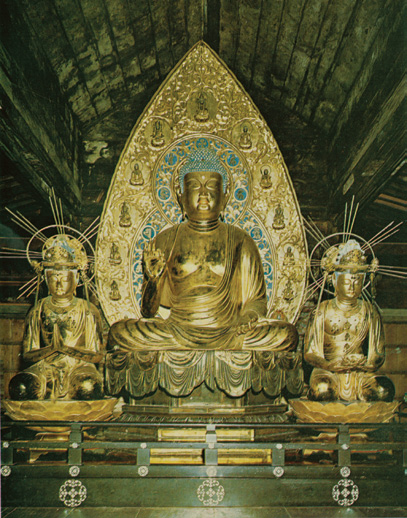An Illustrated Outline of Buddhism: The Essentials of Buddhist Spirituality (24 page)
Read An Illustrated Outline of Buddhism: The Essentials of Buddhist Spirituality Online
Authors: William Stoddart,Joseph A. Fitzgerald
Tags: #Philosophy


77
(14) The Six Paramitas
(“Virtues of the Bodhisattva”)
Pāramitā
means literal y “that which has reached the other shore” (see
p. 134). In
Mahāyāna
Buddhism, it is taught that the six
pāramitā
s
are the virtues of the Bodhisattva.
These are:
dāna
(“charity”),
shīla
(“abstention”),
kshānti
(“patience”),
vīrya
(“virility”),
dhyāna
(“contemplation”), and
prajñā
(“wisdom”).
Some symbolic correspondences with the directions of space, the
elements, and the
Dhyāni-Buddha
s
are shown below.1
1
2
shīla
(“abstention”)
vīrya
(“virility”)
N — earth
E — air
Amogasiddhi
Akshobya
3
4
kshānti
(“patience”)
dāna
(“charity”)
W — water
S — fire
Amitābha
Ratnasambhava
5
6
dhyāna
(“contemplation”,
prajñā
(“wisdom”, “union”)
“discernment”)
ZENITH — ether
NADIR — Void (
Shūnyatā
)
Vairochana
Vajradhara (Mahāvairochana)
1 See the chapter on the “Synthesis of the
Pāramitā
s” in Frithjof Schuon,
Treasures of
Buddhism
, pp. 126-127.


78
An Illustrated Outline of Buddhism
Amida Buddha flanked by Dai-Seishi and Kwannon, Kyoto, Japan, 1148
Even as one who desires to reach a longed-for city requires eyes
to see the way and feet to traverse it, so also the one who desires
to reach the City of
Nirvāna
requires the eyes of Doctrine and
the feet of Method.
Prajñā-Pāramitā-Sūtra


79
(15) The Original Vow and the Pure Land School
The Buddha made forty-eight vows (
pranidhāna
s),
of which the eigh-
teenth, called by Hōnen “the king of the vows”, is known as the “Origi-
nal Vow”:
When I have attained the state of Buddha
(“Enlightened”), if
the beings in the ten regions (of the universe), who have be-
lieved in Me with a calm mind, have desired to be born again
in my Country, and have remembered (thought on) Me, be
it only ten times, are not reborn there, may I not obtain Per-
fect Knowledge. Excepted are only those who have commit-
ted the five mortal sins and have blasphemed the Good Law.
(
Sukhāvatī-Vyūha-Sūtra
,
major, 8:18)
In the
Amitāyur-Dhyāna-Sūtra
, the Buddha reiterates this prom-
ise by telling the story of “Dharmākara’s Vow”: a Bodhisattva
called
Dharmākara, when on the threshold of
Nirvāna
,
made a vow not to
enter therein if, once he had become Buddha
(“Enlightened”), he were
unable to offer a Paradise of Purity to all who pronounced his Name—
henceforth nirvanic or divine—with unmixed faith and in the convic-
tion of being incapable of saving themselves by their own merits. Hav-
ing achieved Buddhahood
under the Name of Amitābha
or Amitāyus
(the two go together), the celestial Personage keeps his word: by the
power of his Name he delivers a multitude of believers. The Buddha
Shākyamuni participates in this work by retelling Dharmākara’s story
and thus bringing it to the attention of mankind. The Paradise to be
attained is the “Pure Land” (
Sukhāvatī
,
literal y “land of bliss”) or the
“Western Paradise” over which Amitābha
(Japanese Amida)
reigns.
Amitābha =
infinite light — equated with
prajñā
(wisdom)
Amitāyus =
infinite life — equated with
karunā
(compassion)
Reference was made on pp. 40-43 to the presence, in all the great
religions, of the spiritual method that is based on the invocation of a
revealed Divine Name:
japa-yoga
in Hinduism, the “Jesus Prayer” in
Eastern Christianity, and
dhikr Allāh
(the “remembrance of God”) in
Islam. In Buddhism this invocatory method is known as the “remem-
brance of the Buddha”:
Buddhānusmriti
(Sanskrit),
nien-fo
(Chinese),
and
nembutsu
(Japanese).

80
An Illustrated Outline of Buddhism
This “remembrance” or “invocation” is the central spiritual prac-
tice of the Pure Land School of Buddhism (Sanskrit
Sukhāvatī
, Chi-
nese
Ching-t’u
,
Japanese
Jōdo
),
the scriptural basis of which is the Buddha’s “Original Vow”. The invocatory formula (
mantra
)
of the “Pure
Land” school is:
Namo ‘mitābhaya Buddhāya
(Sanskrit)
Na-mu O-mit’o Fu’
(Chinese)
Namu Amida Butsu
(Japanese)
The literal meaning of this invocation or
mantra
is:
“I take refuge
in the Buddha of Infinite Light and Infinite Life.” (For the original San-
skrit and Chinese scripts, see pp. 106-107.) Its solemn and prayerful
repetition is a “sacrament”, a means of grace, at the heart of which lies
an unquestioning faith in the saving power of the revealed Name.
The Hindus emphasize the particular appositeness and efficacy
of
japa-yoga
in the context of mankind’s spiritual weakness in these
latter days of decadence (the
Kali-Yuga
).
Analogously, the Pure Land
school of Buddhism emphasizes the appositeness and efficacy of the
doctrine and practice of
nembutsu
in the
mappō
, “the decadent age of
the
Dharma
”.
This method of salvation through the continual invocation of a
revealed Name of the Divinity (or the Absolute) is an example of what
St. Paul called “prayer without ceasing”. Its particularity lies in the fact
that it is accessible to all (i.e. to sinners), on the one condition that they
have a total trust in the Divine Mercy—or, in this case, in the Bud-
dheic Grace. Unlike the spiritual methods of earlier ages, this spiritual
method is (apparently and outwardly) “easy”; that is to say, it does not
require
a priori
severe fasting, prolonged liturgies, arduous pilgrimag-
es, etc. It is based exclusively on faith and prayer—these being implic-
itly and logical y accompanied by “good works”. From another point
of view, however, this method is far from easy, as it demands from the
one following it a commitment that is both enduring and profound.1
1 See
Treasures of Buddhism
by Frithjof Schuon, pp. 141-142 (note 4) and pp. 154-158.

